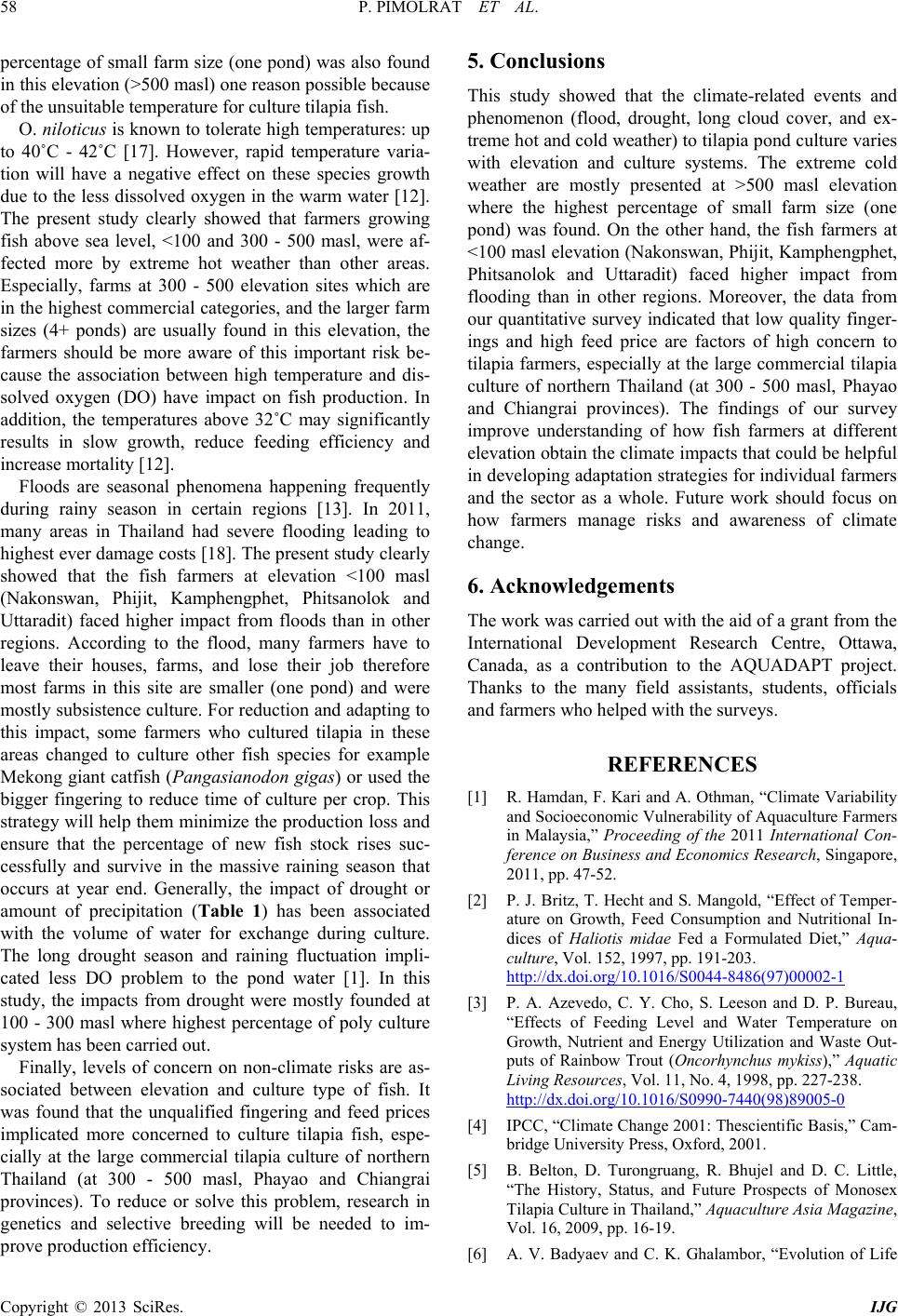
P. PIMOLRAT ET AL.
Copyright © 2013 SciRes. IJG
percentage of small farm size (one pond) was also found
in this elevation (>500 masl) one reason possible because
of the unsuitable temperature for culture tilapia fish.
O. niloticus is known to tolerate high temperatu res: up
to 40˚C - 42˚C [17]. However, rapid temperature varia-
tion will have a negative effect on these species growth
due to the less dissolved oxygen in the warm water [12].
The present study clearly showed that farmers growing
fish above sea level, <100 and 300 - 500 masl, were af-
fected more by extreme hot weather than other areas.
Especially, farms at 300 - 500 elevation sites which are
in the highest commercial categories, and the larger farm
sizes (4+ ponds) are usually found in this elevation, the
farmers should be more aware of this important risk be-
cause the association between high temperature and dis-
solved oxygen (DO) have impact on fish production. In
addition, the temperatures above 32˚C may significantly
results in slow growth, reduce feeding efficiency and
increase mortality [12].
Floods are seasonal phenomena happening frequently
during rainy season in certain regions [13]. In 2011,
many areas in Thailand had severe flooding leading to
highest ever damage costs [18]. The present study clearly
showed that the fish farmers at elevation <100 masl
(Nakonswan, Phijit, Kamphengphet, Phitsanolok and
Uttaradit) faced higher impact from floods than in other
regions. According to the flood, many farmers have to
leave their houses, farms, and lose their job therefore
most farms in this site are smaller (one pond) and were
mostly subsistence culture. For reduction and adapting to
this impact, some farmers who cultured tilapia in these
areas changed to culture other fish species for example
Mekong giant catfish (Pangasianodon gigas) or used the
bigger fingering to reduce time of culture per crop. This
strategy will help them minimize the production loss and
ensure that the percentage of new fish stock rises suc-
cessfully and survive in the massive raining season that
occurs at year end. Generally, the impact of drought or
amount of precipitation (Table 1) has been associated
with the volume of water for exchange during culture.
The long drought season and raining fluctuation impli-
cated less DO problem to the pond water [1]. In this
study, the impacts from drought were mostly founded at
100 - 300 masl where highest percentage of poly culture
system has been carried out.
Finally, levels of concern on non-climate risks are as-
sociated between elevation and culture type of fish. It
was found that the unqualified fingering and feed prices
implicated more concerned to culture tilapia fish, espe-
cially at the large commercial tilapia culture of northern
Thailand (at 300 - 500 masl, Phayao and Chiangrai
provinces). To reduce or solve this problem, research in
genetics and selective breeding will be needed to im-
prove pr od uc tion effi c iency.
5. Conclusions
This study showed that the climate-related events and
phenomenon (flood, drought, long cloud cover, and ex-
treme hot and cold weather) to tilapia pond culture var ies
with elevation and culture systems. The extreme cold
weather are mostly presented at >500 masl elevation
where the highest percentage of small farm size (one
pond) was found. On the other hand, the fish farmers at
<100 masl elevation (Nakonswan, Phijit, Kamphengphet,
Phitsanolok and Uttaradit) faced higher impact from
flooding than in other regions. Moreover, the data from
our quantitative survey indicated that low quality finger-
ings and high feed price are factors of high concern to
tilapia farmers, especially at the large commercial tilapia
culture of northern Thailand (at 300 - 500 masl, Phayao
and Chiangrai provinces). The findings of our survey
improve understanding of how fish farmers at different
elevation obtain the climate impacts that could be helpful
in developing adaptation s trategies for individual f armers
and the sector as a whole. Future work should focus on
how farmers manage risks and awareness of climate
change.
6. Acknowledgements
The work was carried out with the aid of a grant from the
International Development Research Centre, Ottawa,
Canada, as a contribution to the AQUADAPT project.
Thanks to the many field assistants, students, officials
and farmers who he lpe d with the surveys.
REFERENCES
[1] R. Hamdan, F. Kari and A. Othman, “Climate Variability
and Socioeconomic Vulnerability of Aquaculture Farmers
in Malaysia,” Proceeding of the 2011 International Con-
ference on Business and Economics Research, Singapore,
2011, pp. 47-52.
[2] P. J. Britz, T. Hecht and S. Mangold, “Effect of Temper-
ature on Growth, Feed Consumption and Nutritional In-
dices of Haliotis midae Fed a Formulated Diet,” Aqua-
culture, Vol. 152, 1997, pp. 191-203.
http://dx.doi.org/10.1016/S0044-8486(97)00002-1
[3] P. A. Azevedo, C. Y. Cho, S. Leeson and D. P. Bureau,
“Effects of Feeding Level and Water Temperature on
Growth, Nutrient and Energy Utilization and Waste Out-
puts of Rainbow Trout (Oncorhynchus mykiss),” Aquatic
Living Resources, Vol. 11, No. 4, 1998, pp. 227-238.
http://dx.doi.org/10.1016/S0990-7440(98)89005-0
[4] IPCC, “Climate Change 2001: Thescientific Basis,” Cam-
bridge University Press, Oxford, 2001.
[5] B. Belton, D. Turongruang, R. Bhujel and D. C. Little,
“The History, Status, and Future Prospects of Monosex
Tilapia Culture in Thailand,” Aquaculture Asia Magazine,
Vol. 16, 2009, pp. 16-19.
[6] A. V. Badyaev and C. K. Ghalambor, “Evolution of Life